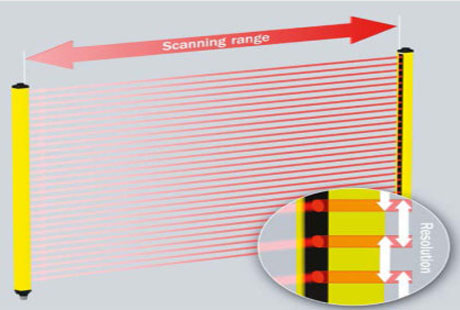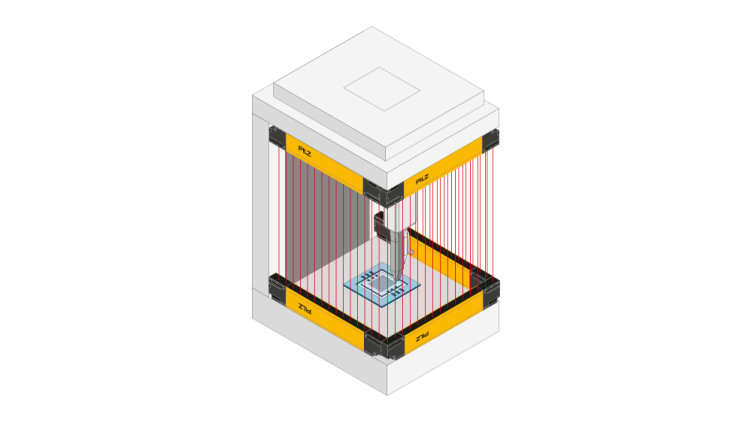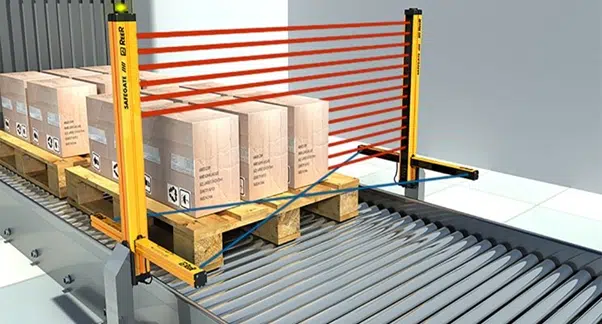
25
How Do Safety Light Curtains Work?
Understanding Safety Light Curtains
Safety light curtains are advanced presence-sensing devices designed to protect operators from dangerous machinery while allowing safe, hands-free access to work zones. Common in industrial automation, these devices emit a field of invisible infrared beams between a transmitter and receiver. If any beam is interrupted—by a hand, tool, or person—the system sends a stop signal to the machine. Compared to traditional physical barriers, safety light curtains offer greater flexibility and efficiency, especially in high-speed or robotic environments. They are ideal for applications requiring both fast access and reliable protection.
How Safety Light Curtains Work
Transmitter & Receiver
The transmitter emits pulsed infrared beams across the danger zone, while the receiver continuously monitors them. When all beams are intact, the machine operates normally. If even one beam is blocked, the receiver triggers a stop via the connected safety relay, instantly halting the machine. High-performance systems feature alignment indicators, built-in diagnostics, and noise immunity, ensuring accurate detection—even in dusty or reflective environments.
Infrared Beam Field & Interruption
The core detection system is a field of precisely spaced infrared beams. Beam spacing (resolution) determines the type of detection: finger, hand, or body. For example, in robotic assembly lines, a high-resolution grid (14 mm) can detect small intrusions like fingertips. When a beam is broken, the system reacts in milliseconds, providing rapid shutdown and preventing injury.
Key Features of Safety Light Curtains
Resolution is the smallest object size the system can detect. Fine resolutions (e.g., 14 mm) are used near points of operation for finger protection, while larger spacings (30 mm or more) support hand or body detection at safer distances. Choosing the right resolution is crucial for regulatory compliance and effective machine guarding.
The Scanning Range defines how far apart the transmitter and receiver can be. Some models span up to 30 meters, ideal for long conveyor systems or wide robotic cells. Proper range selection avoids false triggers and ensures full coverage of hazardous areas.
The Protective Field Height measures the vertical coverage of the detection zone. Taller fields protect full-body access points, while shorter ones target hand or finger zones. Matching field height to the machine’s risk area ensures effective protection without obstructing workflow.
Active safety light curtains use separate transmitter and receiver units. Passive models, in contrast, use one active unit and a reflector, simplifying installation in tight spaces. Both types maintain reliable protection but differ in mounting flexibility.
Types of Safety Light Curtains
Type 2 Light Curtains
Type 2 models are suitable for low-risk applications, such as small packaging or semi-automatic machines. They meet Performance Level c (PLc) or SIL 1, offering basic protection without advanced fault detection. Ideal for operations prioritizing cost-efficiency where risks are moderate.
Type 4 Light Curtains
Type 4 light curtains light curtains are built for high-risk environments, offering redundant circuitry and self-monitoring capabilities. They meet Performance Level e (PLe) or SIL 3 standards, suitable for robotic cells, press brakes, or automated cutting. Their fine resolution and high reliability make them the go-to for critical safety applications.
Programmable Functions
Muting
Muting allows safety light curtains to be temporarily bypassed during non-hazardous material flow, such as pallets moving on conveyors. These are commonly used in packaging and logistics and controlled via safety PLCs and auxiliary sensors.
Blanking
Blanking disables specific beams—either fixed or floating—allowing safe obstruction from fixtures or cables. These are useful in welding stations or other areas where obstructions are part of normal operation, without compromising safety.
Beam Coding
In facilities with multiple light curtains, beam coding prevents cross-talk by assigning unique signal patterns. This ensures only the intended transmitter communicates with its receiver, avoiding false trips in closely spaced setups.
Common Applications
Point of Operation Control
Safety light curtains are essential for point-of-operation guarding on machines like press brakes, stamping presses, and pick-and-place robots. When mounted close to dangerous zones, they instantly stop operations if an operator’s hand enters the field, ensuring compliance without bulky guards.
Perimeter Guarding
Used for full-body detection, perimeter guarding protects large work zones or robotic cells. These systems form multi-sided barriers, shutting down equipment if someone enters the area. It’s a practical alternative to physical fencing, promoting safety without sacrificing access.
Benefits of Safety Light Curtains
Increased Operator Safety
These systems are engineered to prevent serious injuries by detecting intrusions faster than traditional guards. They’re key to meeting international safety regulations like ISO 13855, ISO 13849, and AS 4024.1, enhancing overall plant safety.
Improved Productivity
Safety light curtains support faster operations by eliminating the delays of physical doors or cages. Operators can load or unload materials seamlessly, and diagnostics tools help reduce setup and maintenance time. The result: higher uptime and greater efficiency.
Installation Best Practices
Correct installation ensures full safety and performance. Factors to consider:
- Minimum safe distance from the hazard
- Proper alignment of transmitter and receiver
- Avoiding reflective surfaces or obstructions
- Integration with safety relays or PLCs for automatic response
Post-installation, systems must be tested and validated to confirm machine safety compliance.
Compliance and Regulations
Safety light curtains must align with regulatory standards:
- ISO 13855 for sensor positioning
- ISO 13849 / IEC 62061 for functional safety
- AS 4024.1 for Australian compliance
Systems are rated by Performance Level (PL) or Safety Integrity Level (SIL). Correct classification ensures equipment is matched to risk assessments and remains legally compliant through routine inspections and documentation.
Emerging Trends in Light Curtain Technology
As Industry 4.0 advances, safety light curtains are evolving too. Key innovations include:
- IO-Link compatibility: Enables real-time data exchange, predictive maintenance, and simplified setup via smart controllers.
- Compact high-resolution models: Suitable for electronics and precision robotics, offering protection in space-constrained setups.
- Rugged designs: Built for harsh environments with dust, water, or vibration exposure.
- Safety over Ethernet: Integrates light curtains into networked safety systems, allowing remote diagnostics, performance monitoring, and centralized control.
- Modular safety systems: Light curtains are now part of flexible, reconfigurable safety architectures for adaptable production lines.
Beyond Light Curtains – Safety Monitoring & Output Products
While selecting a robust safety input method is vital to any industrial safety system, equally critical is the ability to monitor and respond appropriately to those inputs. The safety monitoring and output range at Venus Automation provides tailored solutions to meet the needs of diverse machines and projects.
A key component in modern safety systems is the safety PLC. These programmable devices allow custom safety logic, with flexible input/output terminal assignments. Venus Automation offers a variety of models, including the MOSAIC PLC from ReeR, Samos PLC from Wieland, and GEMNIS PLC from Pizzato—each delivering advanced and reliable safety functionality.
Where complex programmability is unnecessary, alternative options such as safety relays are available. These include standalone relays, time-delay relays, speed-monitoring relays, standstill monitoring and timer relays, PCB relays and relay expansion modules. Also important are type-specific control relays, like the emergency stop relay, safety edge relay, light curtains relay, or two-hand control relay. These options provide effective and application-specific safety responses.
Regardless of input device or control relay, the emergency stop remains integral to any safety architecture, albeit not providing direct monitoring. To provide a complete solution, emergency stop accessories are also available, as well as emergency stop variants such as rope pull switches, and standard non safety-rated pushbuttons. Emergency stops are also sold integrated on other safety monitoring devices such as two-hand stations. Finally, Wireless safety systems, including wireless emergency stop units or remote controls and accessories, are also available.
Additional safety monitoring components include the safety encoder, which monitors motor speed, and interlock devices such as tongue solenoid interlock switch or electro-magnetic switches. For more complex safety guarding, multifunctional gatebox units provide a consolidated interface, easily mounted on protective enclosures, such as concertina guards.
Access restriction and control can also be achieved through electronic key systems, ensuring machinery operates only under authorized conditions. To connect chosen elements together, contact blocks are readily available. Finally, for output-side protection, safety contactors and pneumatic safety valve solutions are available to ensure reliable machine stoppage when hazardous conditions are detected.



